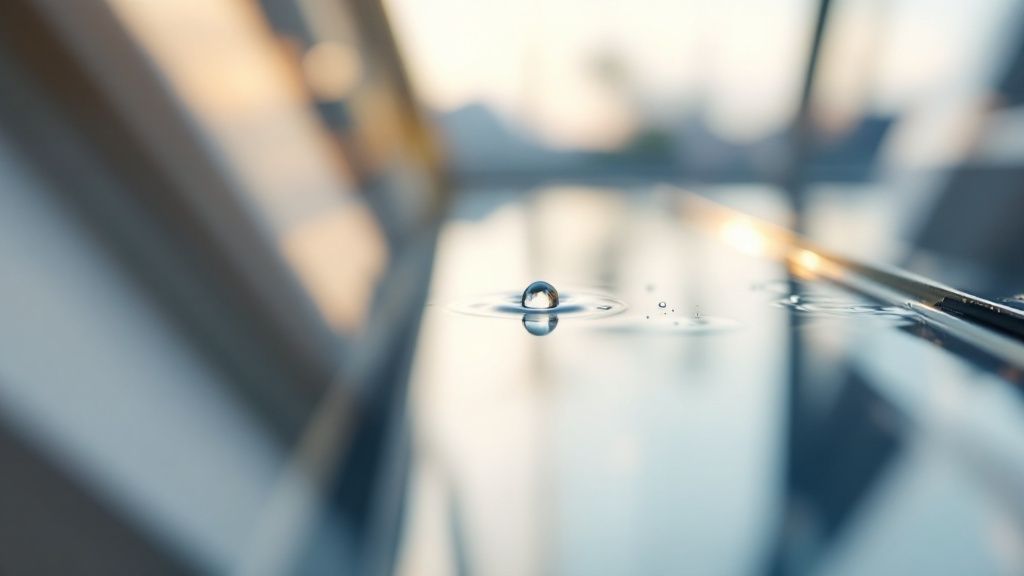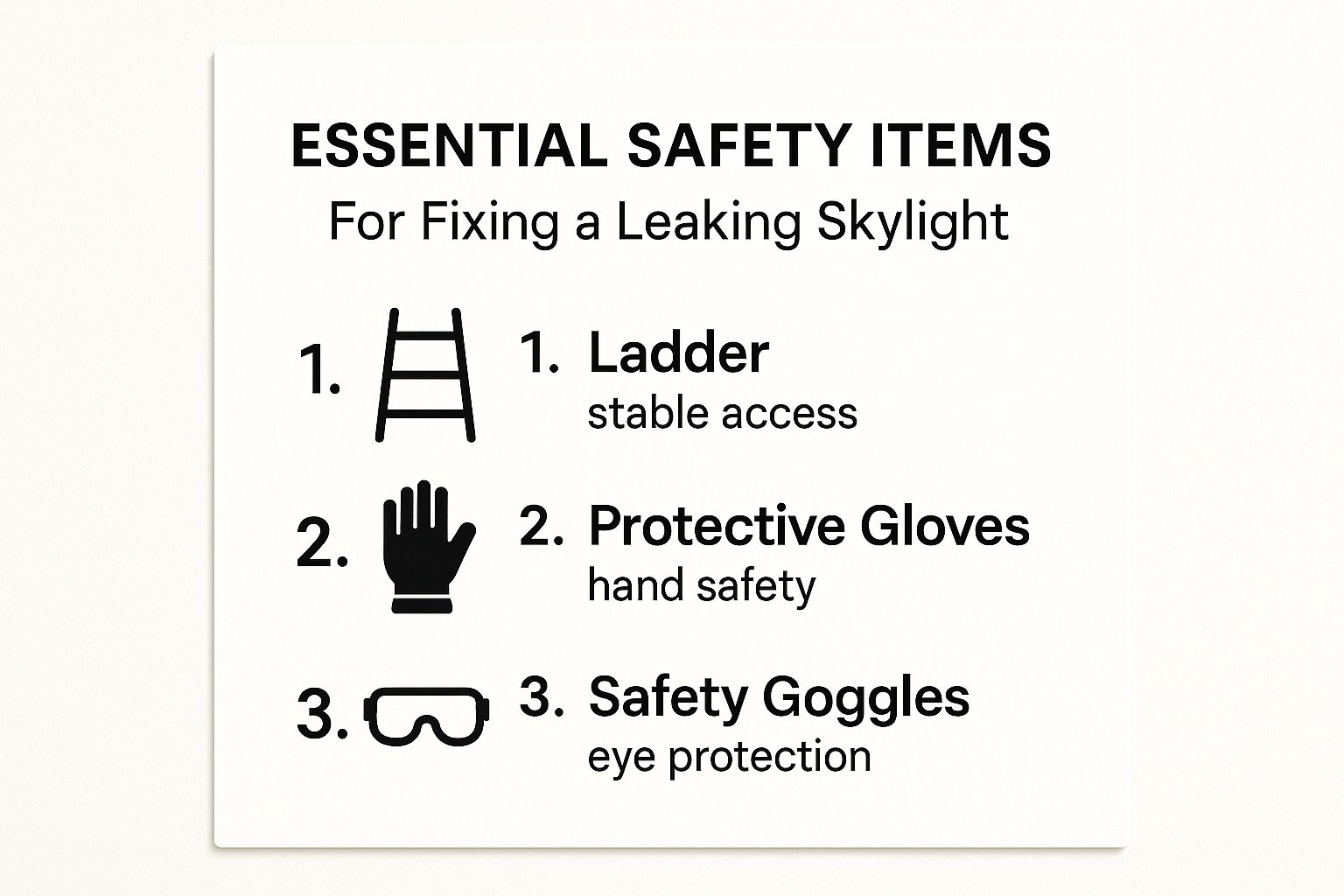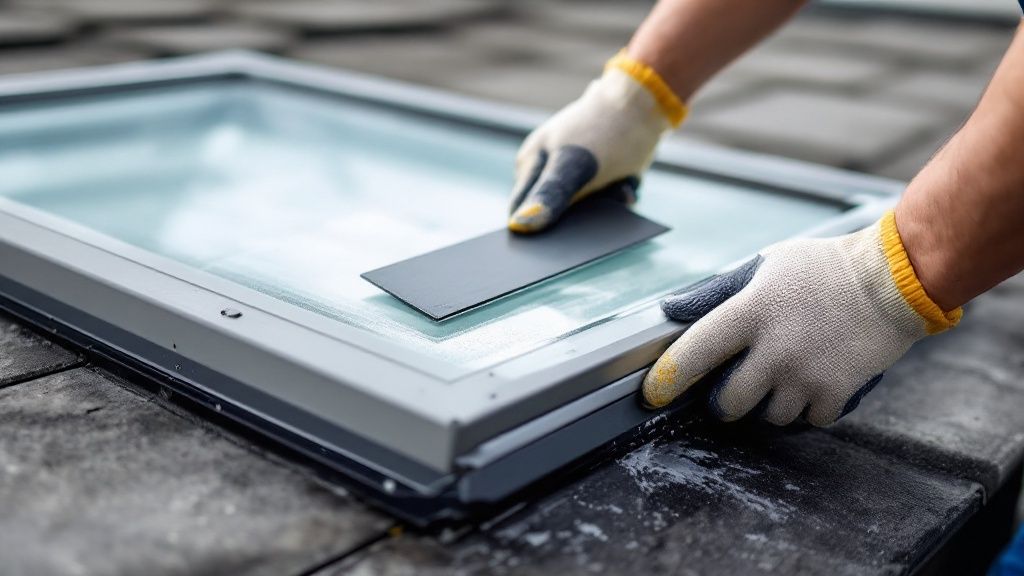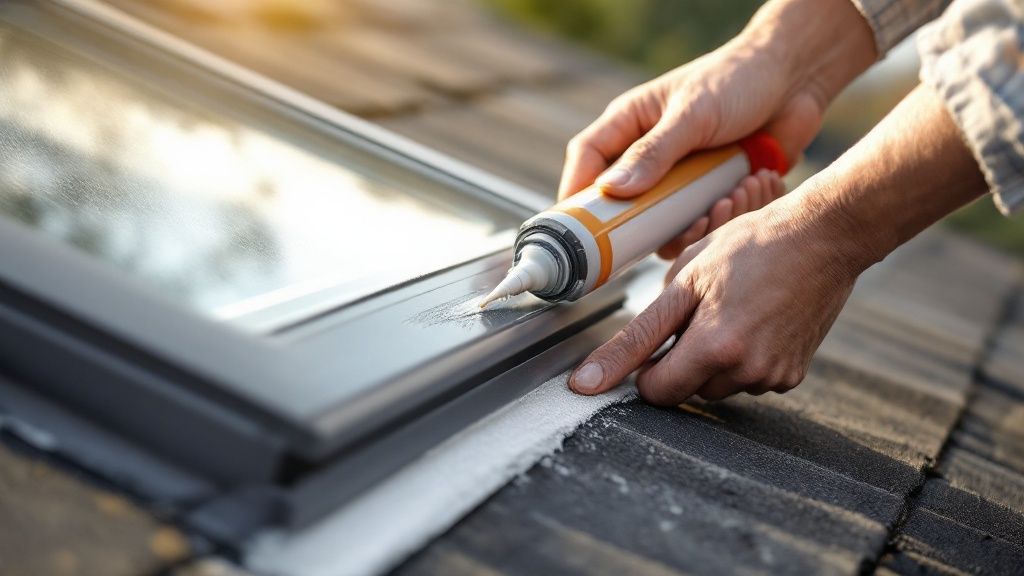
Understanding Why Your Skylight Is Leaking

Identifying the source of a leaking skylight is the first step to a lasting solution. Surprisingly, the glass itself is rarely the problem. More often, the issue lies with the surrounding components.
This means paying close attention to areas like the flashing. Flashing is the metal sheeting that forms a watertight seal between the skylight and your roof. Given Australia’s intense sun and regular rainfall, this flashing can corrode or become damaged over time.
Sealant also plays a crucial role in preventing water from entering your home. These sealants, usually found around the skylight frame and flashing, can deteriorate with age and exposure to the elements. Cracked or missing sealant offers an easy entry point for water. This is particularly problematic in coastal areas, where salt air accelerates the deterioration process.
Common Causes of Skylight Leaks
Faulty installation is another frequent cause of leaks. Incorrectly installed flashing or insufficient sealant can lead to problems immediately or leaks that develop gradually. Even a slight misalignment of the skylight itself can create weaknesses.
For instance, if a skylight isn’t level, water can pool, stressing the seals and flashing. This concentrated pressure can eventually lead to leaks.
However, not all moisture around your skylight signals a leak. Condensation, a common culprit often mistaken for a leak, happens when warm, moist air inside your home contacts the cold surface of the skylight. This results in water droplets forming on the inside of the glass, a phenomenon especially common in winter. This situation requires improved ventilation, not roof repairs.
The Importance of Skylight Maintenance in Australia
Regular maintenance is crucial for preventing skylight leaks. Frequent cleaning and inspections can help identify potential issues early on. In Australia, skylight maintenance is especially important for preventing leaks and maximizing their lifespan.
Homeowners should watch for telltale signs like persistent leaks, water stains around the skylight, or visible cracks and damage. Regular cleaning and checks are vital to prevent issues like corrosion and staining from accumulated leaf debris.
In harsher environments like coastal areas or regions with high pollution, skylights should ideally be cleaned every 6 months to prevent damage. While simple cleaning and minor repairs can be handled by homeowners, more complex issues often require a professional. This ensures safety and helps extend the skylight’s life. In the long run, regular maintenance can significantly reduce the need for costly repairs or replacements. Understanding the root cause of your leak helps you choose the right solution, whether it’s a simple DIY fix or contacting a professional.
Diagnosing Your Skylight Leak Like a Professional
Before calling a contractor, it’s essential to identify the source of your skylight leak. Using a systematic approach, like professional inspectors, can save you time and money in the long run.
Accessing Your Skylight Safely
Safety should always be your top priority. Use a secure ladder and have someone assist you, if possible. Before even touching the skylight, gather the necessary safety equipment. The infographic below illustrates the essentials:

These three pieces of safety equipment—a ladder, gloves, and goggles—are crucial. Gloves protect your hands from sharp edges, while goggles protect your eyes from dust and debris. A stable ladder ensures safe access to the skylight and minimizes the risk of falls. Never attempt to access your skylight during inclement weather.
Identifying Telltale Signs of Leaks
Once safely positioned, examine the skylight from both inside and outside. Look for visible signs like cracks in the glazing, damaged flashing, or deteriorated sealant. Inside, check for water stains on the ceiling or walls surrounding the skylight. These stains often indicate the general area of the leak, but the actual source might be higher up. Water can travel along rafters and beams before becoming visible.
Pinpointing the Source
To confirm your suspicions, use a hose to simulate rainfall around the suspected leak area. Start low and gradually move the hose higher, observing inside for any water entry. This helps isolate the exact location of the leak. Also, check for dampness around the frame and look for any gaps or cracks.
Documenting Your Findings
Document everything with photos and detailed notes. This is crucial for informed repair decisions and for clearly explaining the situation to contractors. This documentation can also be invaluable for insurance claims. Clear photographs of the water damage will strengthen your claim.
To help distinguish between a leak and condensation, use the table below.
The following table highlights the key differences between a skylight leak and condensation.
| Symptom | Likely a Leak | Likely Condensation |
|---|---|---|
| Water stains on ceiling or walls | Yes | Possibly, especially in cold weather |
| Visible cracks or gaps in skylight frame or sealant | Yes | No |
| Dampness or dripping concentrated in one area | Yes | No, condensation is usually more widespread |
| Water appears after rain | Yes | Possibly, if humidity is high |
| Water appears regardless of weather | No | Yes, especially in temperature fluctuations |
| Frost or ice buildup on the inside of the skylight in winter | No | Yes |
By understanding these distinctions, you can better assess your skylight issue.
Emergency Measures
If heavy rain is expected, take immediate action to protect your home. Cover the skylight with a heavy-duty tarp secured with weights or strong tape. This temporarily prevents further water damage. Placing buckets inside can catch dripping water. Remember, these are temporary solutions. Addressing the underlying leak is crucial. By methodically diagnosing your skylight leak, you’ll be prepared to fix the problem effectively and prevent future issues.
DIY Repairs That Actually Stop Skylight Leaks

A leaky skylight can be a frustrating problem. Fortunately, many minor to moderate leaks are fixable with some DIY skills and the right supplies. This guide offers some practical solutions for common skylight issues.
Repairing Deteriorated Sealant
One of the most common culprits behind skylight leaks is deteriorated sealant. Australia’s harsh weather, with its intense sun and heavy downpours, can cause sealant to crack and peel. This creates openings for water to get in.
To fix this, you’ll need a good quality silicone sealant designed for roofing and skylights. Look for a UV-resistant product suitable for wet and dry conditions. Before applying the new sealant, completely remove the old, damaged sealant with a scraper or utility knife.
Clean the area with a suitable solvent and make sure it’s completely dry. Apply the new sealant in a continuous bead, ensuring a complete seal around the skylight frame and flashing. This creates a watertight barrier.
Addressing Minor Flashing Problems
Damaged or corroded flashing is another frequent cause of leaks. Flashing is the metal sheeting that seals the skylight to the roof. It can lift or rust, creating weak points. Minor flashing issues, like small gaps or lifted edges, can often be repaired with flashing sealant or roofing cement.
For bigger problems, replacing the flashing might be necessary, and this often requires professional help. Skylight lifespan in Australia varies. Glass skylights typically last 10-30 years (or more), while polycarbonate or acrylic versions tend to last 8-15 years. Learn more about skylight lifespans here.
For smaller fixes, apply flashing sealant or roofing cement generously to the damaged area. Ensure complete coverage and a smooth finish to prevent water from getting in.
Resealing Frame Seals
Deteriorating frame seals can also let water seep in. Replacing them is usually a simple job. Measure your skylight frame and buy replacement seals that match.
Carefully remove the old seal and clean the area thoroughly. Install the new seal by pressing it firmly into place. This will restore the frame’s integrity and prevent leaks.
Common DIY Mistakes to Avoid
Even experienced DIY enthusiasts can make mistakes when fixing a leaky skylight. Applying sealant to a wet surface is a common error. The sealant won’t adhere properly, potentially leading to future leaks.
Another mistake is not removing all the old sealant before applying the new one. This creates a weak point in the repair. For more information, see our guide on skylight categories.
Preparing for Long-Lasting Repairs
Proper preparation is crucial for long-lasting skylight repairs. Always check the weather forecast before working on your roof. Dry, calm conditions are essential for sealant to adhere properly and the repair to be effective.
Have all your tools and materials ready before you start. This includes a ladder, safety gear, sealant, scraper, cleaning supplies, and anything else you need for your specific repair.
By avoiding common mistakes and taking precautions, you can greatly improve your chances of a successful, long-lasting repair. This not only fixes the current leak but also helps prevent future ones, saving you time, money, and hassle.
When To Call The Professionals: Serious Leak Solutions

While some minor skylight leaks can be tackled with DIY fixes, more serious issues often demand the expertise of a professional. Knowing when to bring in the pros can prevent further damage and save you money in the long run. This involves recognizing the limitations of DIY and understanding the advantages of professional help.
Signs You Need Professional Help
Several key indicators suggest it’s time to contact a skylight repair specialist. If you’ve tried DIY repairs and the leak continues, it’s a good sign the problem is more complicated than it seems. This might point to hidden structural problems or major damage to the flashing. These issues require specialized tools and knowledge to repair properly.
Persistent leaks can lead to significant water damage. Look for signs like damp insulation, ceiling stains, or mold growth. These are clear indicators that a professional should assess the situation. Such damage can have serious consequences for your home’s structure and indoor air quality. Professional skylight repair specialists can thoroughly evaluate the extent of the problem.
Another instance where professional help is crucial is when your skylight has shattered or cracked glass. Replacing glass safely and correctly requires specific expertise. Improper installation can lead to new leaks down the line. For example, poor sealing around the new glass can create fresh entry points for water.
Finally, if you’re not comfortable working at heights or lack the necessary tools and experience for complex repairs, it’s best to call a professional. Skylight repair often involves working on the roof. This can be dangerous without the right safety equipment and training.
What To Expect During Professional Repairs
Professional skylight repairs begin with a comprehensive inspection to identify the precise source of the leak. This usually involves checking the flashing, sealant, frame, and glass for damage. This thorough assessment ensures the root cause is addressed, not just the visible symptoms.
The actual repair work will depend on the specific issue. It might involve resealing the skylight, replacing the flashing, repairing or replacing the frame, or installing new glass. In cases of severe leaks, a full skylight restoration might be necessary. This involves replacing multiple components.
Understanding the Costs
The cost of professional skylight repair in Australia depends on the damage and the type of repair needed. To give you a better idea, let’s look at a cost comparison table.
To help illustrate the typical costs associated with professional skylight repair in Australia, we’ve put together the following table:
Professional Skylight Repair Cost Comparison
This table outlines the typical costs for different professional skylight repair options in Australia.
| Repair Type | Average Cost Range | When It’s Necessary | Expected Lifespan of Repair |
|---|---|---|---|
| Resealing | $200 – $500 | Minor leaks, deteriorated sealant | 5-10 years |
| Flashing Replacement | $400 – $800 | Damaged or corroded flashing | 10-15 years |
| Frame Repair/Replacement | $500 – $1,200 | Rotting or damaged frame | 10-20 years |
| Glass Replacement | $600 – $1,500 | Cracked or broken glass | 15-25 years |
| Full Skylight Restoration | $1,500 – $3,000+ | Extensive damage, multiple components needing replacement | 20+ years |
As you can see, the cost can range significantly depending on the complexity of the repair. Remember, these are estimates, and it’s always a good idea to get multiple quotes from reputable contractors before making a decision.
Choosing The Right Contractor
Choosing a qualified contractor is key for successful skylight repair. Ask potential contractors about their experience with skylight-specific repairs. Check for relevant licenses and insurance, and don’t forget to ask for references. A reputable contractor will gladly answer your questions and provide proof of their qualifications. Verify their expertise in skylight repairs specifically; general roofing experience doesn’t always translate to specialized skylight knowledge.
Navigating Insurance Claims
If the skylight leak is due to storm damage or other covered events, your insurance might cover the repair costs. Document the damage thoroughly with photos and videos. Contact your insurer promptly to file a claim and follow their instructions carefully. Be sure to keep records of all communication and receipts related to the repair.
By understanding when to call a professional, what to expect during the repair process, and how to choose a qualified contractor, you can ensure your leaking skylight is fixed effectively and efficiently. This protects your home and provides peace of mind.
Preventing Future Leaks: The Maintenance Mastery Plan
Want to transform your skylight from a leak-prone headache to a reliable source of natural light? The key is proactive maintenance. This means regular inspections, cleaning, and addressing minor issues before they become major problems. This guide provides a seasonal maintenance approach designed specifically for Australian conditions.
A Seasonal Approach to Skylight Maintenance
Australia’s varied climate, from intense summer heat to heavy winter rains, requires a tailored maintenance schedule.
During autumn, clear leaves and debris around your skylight. This prevents blockages that could trap water and cause leaks. Also, check for any damage from high winds or storms.
Winter brings heavy rainfall and sometimes frost. Inspect the flashing and sealant for any cracks or gaps. Make sure your skylight’s drainage system is clear to handle the increased water flow. Inside, keep an eye out for condensation, a potential sign of ventilation issues.
Spring is the perfect time for a deep clean. Wash the skylight glass and frame to remove dirt and grime. This improves light transmission and allows for a clear inspection of the seals. Double-check the flashing and sealant, as temperature changes can cause these materials to expand and contract, potentially leading to weaknesses.
Summer’s intense heat and UV radiation can be tough on sealants and flashing. Inspect these areas carefully and reapply sealant where necessary. A reflective blind or coating can help reduce heat buildup and protect your skylight from prolonged sun exposure.
Specific Maintenance Challenges and Solutions
Different locations present unique challenges for skylight maintenance.
- Coastal Properties: Salt air corrosion is a major concern in coastal areas. More frequent cleaning, ideally every six months, is recommended. Use a mild detergent and rinse thoroughly with fresh water.
- Bushfire-Prone Areas: Extra care is crucial during fire season. Remove flammable debris from around your skylight and ensure your roof is well-maintained to minimize fire risk. After a bushfire, inspect your skylight for damage from heat, smoke, and embers.
- Areas with Temperature Fluctuations: Extreme temperature swings can stress a skylight’s components. Using high-quality, flexible sealants designed for Australian conditions is vital. Regularly inspect the flashing for signs of movement or separation.
Australian skylight regulations are stringent regarding solar heat gain. The National Construction Code (Volume 2) sets standards for Solar Heat Gain Coefficient (SHGC) and U-value, impacting energy efficiency. This makes regular maintenance essential to ensure your skylight continues to meet these requirements. You can explore more about skylights through our product categories.
Professional-Grade Products for Enhanced Protection
Using professional-grade products designed for the Australian climate can significantly extend your skylight’s lifespan and prevent leaks.
- Sealants: High-quality silicone sealants with UV resistance provide superior protection against the harsh Australian sun.
- Flashing: Choose durable, corrosion-resistant flashing materials, especially in coastal areas.
Always apply these products according to the manufacturer’s instructions. Proper surface preparation is crucial for sealant adhesion. Clean the area thoroughly and let it dry completely before applying new sealant.
By following this maintenance plan, you can significantly reduce the risk of skylight leaks and ensure long-term performance. This proactive approach not only protects your home but also maintains your skylight’s energy efficiency, contributing to a more comfortable and sustainable living environment.
Repair or Replace? Making the Smart Investment Decision
Deciding whether to repair or replace your leaking skylight can be a difficult decision. It involves weighing the immediate cost of repairs against the long-term benefits of a new, more efficient skylight. This section will guide you through the process.
Evaluating Your Current Skylight
Begin by assessing the current condition of your skylight. Consider its age, the materials it’s made of, and the number of previous repairs. These factors all contribute to its remaining lifespan and the potential for future leaks. For instance, a skylight nearing the end of its expected life, even with repairs, might be better suited for replacement.
Also, examine the specific type of damage. Minor cracks in the sealant are often easily fixed. However, significant flashing corrosion or a cracked frame could indicate more substantial structural problems. In these cases, repairs might only offer a temporary fix. For additional home maintenance tips, consider checking out this helpful blog.
Calculating the True Cost
Carefully compare the cost of extensive repairs with the cost of a complete replacement. Numerous repairs over a short time can quickly accumulate, potentially surpassing the expense of a brand new skylight. Remember to factor in not only the cost of materials, but also the labor involved, particularly if you’re hiring a professional.
A simple table can help visualize the costs:
| Option | Material Cost | Labor Cost | Energy Savings (estimated annual) | Total |
|---|---|---|---|---|
| Repair | $XXX | $YYY | $0 | $XXX + $YYY |
| Replacement | $AAA | $BBB | $ZZZ | $AAA + $BBB |
This table allows for a clearer comparison of the financial implications of each choice. Remember to include potential energy savings offered by a newer, more energy-efficient skylight.
The Advantages of Modern Skylight Technology
Modern skylights offer considerable advancements in leak resistance and energy efficiency. Advanced flashing systems and integrated water management features are designed to prevent leaks. Improved glazing technology enhances water resistance and provides better insulation, resulting in potential energy savings and increased home comfort. This is especially important in Australia, where energy costs can be substantial.
Upgrading: A Sound Investment
Replacing your skylight can be a wise investment, especially in Australia’s competitive housing market. A new skylight can increase your home’s value by improving natural light and energy efficiency — features that are highly attractive to potential buyers. Increased natural light enhances a home’s aesthetic appeal, creating a brighter and more inviting living area.
Making the Right Choice
Ultimately, the decision to repair or replace depends on your specific situation. By thoroughly assessing your skylight’s condition, calculating all costs, and weighing the long-term benefits of a new skylight, you can make a well-informed decision that suits both your home and your budget. Replacing an older skylight with a modern, energy-efficient model can improve your home’s comfort, lower your energy bills, and increase its overall value.
Modern Skylight Solutions for Leak-Free Performance
If replacing your skylight seems like the best option, choosing the right system is essential for ensuring it lasts. This section explores the newest advancements in skylight design, focusing on how to prevent leaks and what’s suitable for Australian homes. When deciding whether to repair or replace, think about the long-term investment.
Advanced Flashing and Water Management
Modern skylights have several key features that significantly improve their resistance to leaks. Advanced flashing systems, made from durable materials like high-grade aluminum or copper, offer superior protection against corrosion and water damage. Look for flashing systems with integrated water diverters and drip edges to channel water away from the skylight opening. This is especially important in high-rainfall areas like Australia’s eastern coast.
Some skylights even have one-piece flashing systems that eliminate seams and potential leak points, creating a continuous waterproof barrier. Others use flexible flashing membranes that conform to the roof’s contours for a tighter seal.
Skylight Types and Australian Climates
The right type of skylight for you depends on your climate, roof type, and what you want it to do.
- Fixed skylights are popular for bringing natural light into rooms. They are generally more affordable and offer excellent leak resistance.
- Ventilated skylights provide both light and ventilation, beneficial in warmer climates. However, they can be more prone to leaks if not installed and maintained correctly. Make sure they have robust weather seals and good drainage.
- Tubular skylights are a good option for smaller spaces or tricky installation areas. Their compact design and flexible tubing make them very leak-resistant.
Australian climates vary greatly. Double-glazed skylights are ideal for Australian conditions, providing excellent insulation against both heat and cold. In hotter areas, consider skylights with low-E coatings to minimize heat gain.
Advances in Glazing Technology
Glazing technology has greatly improved both water resistance and energy performance. Double glazing, filled with inert gas like argon, provides excellent thermal insulation and reduces condensation. Laminated glass adds strength and safety, lessening the risk of breakage and leaks. Some manufacturers even offer self-cleaning glass with a special coating that breaks down dirt and grime for easier maintenance.
This translates to better energy efficiency, less need for artificial lighting, and a more comfortable home year-round.
Smart Home Integration
Smart home integration adds another level of leak protection and convenience to modern skylights. Rain sensors can automatically close your skylight when it rains, preventing unexpected leaks. Remote operation lets you open and close your skylight from anywhere, giving you more ventilation control.
Installation Considerations for Australian Homes
Proper installation is crucial for a leak-free skylight. Consider your roof type—tiled, metal, or flat—and choose a skylight with a compatible flashing kit. For tiled roofs, the flashing needs to integrate seamlessly with the tiles for a watertight seal. With metal roofs, proper sealant application and secure fastening are essential. Flat roofs need specialized skylights with raised curbs for proper drainage. Hire qualified professionals who specialize in leak-proof skylight installation. Their expertise ensures your new skylight is installed correctly, maximizing its lifespan and minimizing the risk of future leaks.
Choose Vivid Skylights for Guaranteed Performance
Vivid Skylights offers a wide range of high-quality, leak-resistant skylights designed for Australian conditions. Our double-glazed units, frameless top glazing, and robust aluminum frames offer superior performance and durability. With a 10-year leak-free warranty and easy DIY installation options, you can trust Vivid Skylights for a brighter, more comfortable home. Learn more about our products and how we can transform your home with beautiful natural light by visiting https://vividskylights.com.au.
